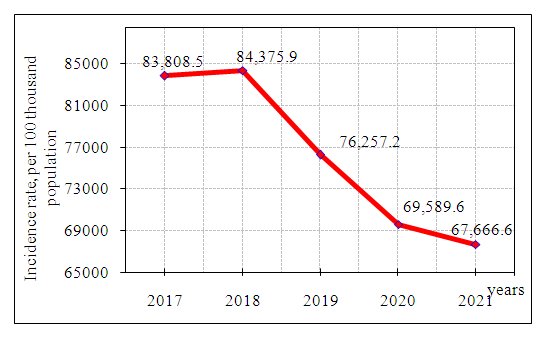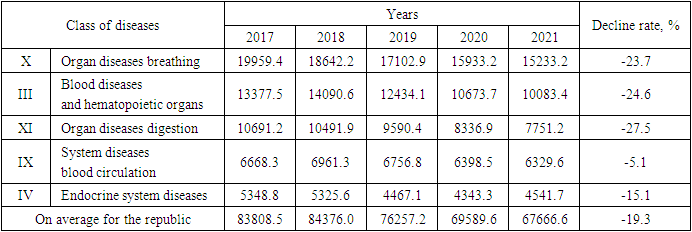-
Paper Information
- Next Paper
- Previous Paper
- Paper Submission
-
Journal Information
- About This Journal
- Editorial Board
- Current Issue
- Archive
- Author Guidelines
- Contact Us
American Journal of Medicine and Medical Sciences
p-ISSN: 2165-901X e-ISSN: 2165-9036
2024; 14(5): 1309-1313
doi:10.5923/j.ajmms.20241405.33
Received: Apr. 17, 2024; Accepted: May 13, 2024; Published: May 18, 2024

Main Trends in Morbidity of the Population of Uzbekistan for 2017-2021
Kamilova R. T., Ataniyazova R. A., Isakova L. I., Mamajonov S. Sh.
Research Institute of Sanitation, Hygiene and Occupational Diseases of the Ministry of Health of the Republic of Uzbekistan
Copyright © 2024 The Author(s). Published by Scientific & Academic Publishing.
This work is licensed under the Creative Commons Attribution International License (CC BY).
http://creativecommons.org/licenses/by/4.0/

The purpose of the studyis to identify dynamic changes in the general morbidity structure of the population of the Republic of Uzbekistan over the studied 5-year period. A retrospective analysis of the general morbidity rate of the population of the Republic of Uzbekistan has been carried out using official statistical materials for the period 2017-2021. The incidence was ranked by disease classes according to ICD-10 and analyzed per 100 thousand population. Calculations and graphical analysis were carried out using the Microsoft program Excel.
Keywords: General morbidity, Structure, and growth rate, Retrospective analysis
Cite this paper: Kamilova R. T., Ataniyazova R. A., Isakova L. I., Mamajonov S. Sh., Main Trends in Morbidity of the Population of Uzbekistan for 2017-2021, American Journal of Medicine and Medical Sciences, Vol. 14 No. 5, 2024, pp. 1309-1313. doi: 10.5923/j.ajmms.20241405.33.
Article Outline
1. Introduction
- Population health is a fundamental aspect of sustainable socio-economic development of any country and investing in healthcare and taking measures to protect the health of the population ensures the long-term sustainability of society [WHO, 2022]. In modern society, there is an increase in the number of chronic diseases of the cardiovascular and endocrine systems, respiratory and digestive organs, mental disorders, etc. Despite progress in medical science and practice, infectious diseases remain a pressing problem. The COVID-19 pandemic has become a prime example of how infectious diseases can impact global health [4].The current structure and dynamics of population morbidity are influenced by various factors, such as lifestyle, demographic situation, and socio-economic and environmental conditions. Some of the main factors are nutritional disorders and unfavorable environmental conditions [2,5].Atmospheric air plays a huge role as an environmental object for human life [1]. Air pollutants, including fine dust particles (PM10 and PM2.5), are a serious problem for the environment and public health [1,3,10]. There are several studies, the results of which indicate a strong connection between dust particles PM 10 and PM 2.5 with diseases of the respiratory system and cardiovascular system, cancer, and reproductive health [6,7]. Depression, anxiety disorders, stress, and other mental and behavioral disorders are more common in regions with environmentally unfavorable conditions [11]. This allows us to emphasize the seriousness of the problem of the impact of atmospheric particles on human health and the need for further research to develop measures to prevent negative consequences [6,7].Considering the multifactorial conditions and causes of the increase in morbidity, the peculiarities of the modern structure, and dynamic changes, the need arose to analyze the general morbidity of the population to determine the effectiveness of the implemented programs in the healthcare of the republic.
2. Literature Review
- The incidence trends in the population of Uzbekistan provide critical insights into the healthcare landscape, disease burden, and public health priorities of the nation. Understanding these trends is vital for policymakers, healthcare professionals, and researchers to implement effective preventive measures, allocate resources efficiently, and develop targeted interventions to address prevalent health issues.Several studies and reports have highlighted the changing patterns of disease incidence and prevalence in Uzbekistan over recent years. A study by Ismailov et al. (2018) reported an increasing trend in the incidence of non-communicable diseases (NCDs), such as cardiovascular diseases, diabetes, and cancer, which are major contributors to morbidity and mortality in the country. The study emphasized the urgent need for comprehensive strategies to tackle the growing burden of NCDs through lifestyle modifications, early detection, and management.In contrast, infectious diseases remain a significant public health concern in Uzbekistan. According to a report by the Ministry of Health of the Republic of Uzbekistan (2019), there has been a notable increase in the incidence of certain infectious diseases, including tuberculosis, hepatitis, and sexually transmitted infections. This rise underscores the importance of strengthening infectious disease control programs, improving vaccination coverage, and enhancing public awareness to mitigate the spread of these diseases.Furthermore, mental health disorders have been increasingly recognized as a growing health issue in Uzbekistan. A study by Karimova et al. (2020) highlighted the rising prevalence of mental health disorders, particularly depression and anxiety, among the Uzbek population. The study emphasized the need for integrated mental health services, community-based interventions, and mental health literacy programs to address the growing mental health burden effectively.Moreover, environmental and occupational health hazards have also emerged as significant contributors to the disease burden in Uzbekistan. Studies have indicated an increase in the incidence of respiratory diseases, such as asthma and chronic obstructive pulmonary disease (COPD), linked to environmental pollution and occupational exposures (Tursunova et al., 2021). Addressing environmental pollution, improving occupational safety standards, and promoting healthy living environments are essential to reduce the incidence of these preventable diseases.In summary, the incidence trends in Uzbekistan reflect a complex interplay of demographic, socio-economic, environmental, and lifestyle factors influencing the health status of the population. Comprehensive public health strategies targeting both communicable and non-communicable diseases, along with mental health and environmental health initiatives, are crucial to improving the health outcomes and well-being of the Uzbek population.The study aims to conduct a retrospective analysis of the general morbidity of the population of the Republic of Uzbekistan for the period 2017-2021.
3. Materials and Methods
- An analysis of the general morbidity rate of the population was carried out using official statistics from the Ministry of Health and materials from the Statistics Agency under the President of the Republic of Uzbekistan for the period 2017-2021. The general morbidity of the population is studied based on a continuous record of all primary applications for medical care in primary healthcare facilities. Morbidity was ranked according to disease classes according to ICD-10. Intensive morbidity indicators are calculated per 100 thousand population, the dynamics indicators are analyzed based on the growth rate to the base morbidity level, the average annual growth rate, and maximum and minimum values studied. The study has been conducted using mathematical-statistical and sampling methods. Calculations and graphical analysis of data were carried out using the Microsoft program Excel.
4. Results and Discussion
- An analysis of the dynamics of morbidity in the population of the Republic of Uzbekistan over a 5-year period (from 2017 to 2021) showed that the overall morbidity rate was characterized by a decrease (Fig. 1).
 | Figure 1. Dynamics of the general morbidity rate of the population of the Republic of Uzbekistan for 2017-2021, per 100 thousand per population |
|
 | Figure 2. The share of the leading classes of diseases in the structure of the general morbidity rate of the population of the Republic of Uzbekistan for 2017-2021, % |
|
5. Conclusions
- In conclusion, the culmination of our study, which aimed to conduct a retrospective analysis of the general morbidity of the Republic of Uzbekistan's population for the period 2017-2021 showed a decrease in the overall morbidity rate of the population of the republic by 19.3%. The first ranking places out of 19 registered classes of diseases were occupied by diseases of the respiratory system (22.9%), blood and hematopoietic organs (16%), and digestive organs (12.3%), the proportion of which was more than 50%. The highest rates of decline in diseases were observed in the XVIII class of diseases - symptoms, signs and deviations from the norm (-70.7%), XV class - disorders of pregnancy, childbirth, the postpartum period (-42.4%) and V class of diseases - mental disorders and behavioral disorders (-37.1%). The observed rate of decline in morbidity is the result of reforms carried out in the republic’s healthcare system.The observed rates of reduction in morbidity in our opinion, are the result of reforms carried out in the republic’s healthcare system and annually implemented targeted social programs aimed at protecting public health.
 Abstract
Abstract Reference
Reference Full-Text PDF
Full-Text PDF Full-text HTML
Full-text HTML
